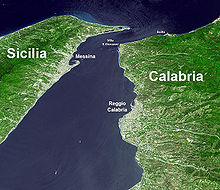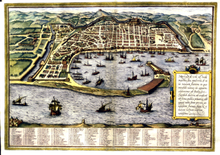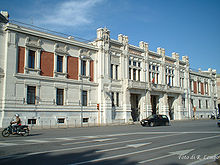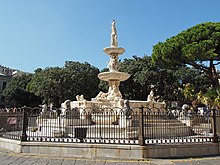Messina
| Messina | ||
|---|---|---|

|
|
|
| Country | Italy | |
| region | Sicily | |
| Metropolitan city | Messina (ME) | |
| Local name | Missina | |
| Coordinates | 38 ° 11 ′ N , 15 ° 33 ′ E | |
| height | 3 m slm | |
| surface | 211.7 km² | |
| Residents | 229,565 (Dec. 31, 2019) | |
| Population density | 1,084 inhabitants / km² | |
| Post Code | 98100 | |
| prefix | 090 | |
| ISTAT number | 083048 | |
| Popular name | Messinesi, Peloritani, Mamertini | |
| Patron saint | Madonna della Lettera (June 3rd) | |
| Website | Messina | |
Messina (originally ancient Greek Ζάγκλη Zanklē , then Μεσσήνη Messēnē , Latin Messana ) with 229,565 inhabitants (as of December 31, 2019) is the third largest city in the Italian region of Sicily and at the same time the administrative seat of the metropolitan city of Messina . Due to its proximity to the Italian mainland, Messina is also called the gateway to Sicily .
In the course of its history, Messina experienced heydays and destruction not only under the changing rulers. Severe earthquakes in 1783 and 1908 as well as the bombing raids in World War II repeatedly destroyed large parts of the city. Today Messina is one of the economic and cultural centers of Sicily.
geography
Geographical data
Messina is located on the northeastern tip of Sicily on the Strait of Messina . The distance to the Italian mainland is only 3 kilometers at the narrowest point. About 90 kilometers south is Catania and about 230 kilometers west is the capital of Sicily, Palermo . The Etna , which with over 3300 m highest volcano in Europe, located about 70 kilometers southwest of the city.
Since a tectonic fault zone, the Messina Fault , runs through the Strait of Messina, earthquakes occur again and again.
climate
Compared to other large cities in Sicily, Messina is the city with the highest amount of rainfall, as it is not in the rain shadow of mountains.
| Messina | ||||||||||||||||||||||||||||||||||||||||||||||||
|---|---|---|---|---|---|---|---|---|---|---|---|---|---|---|---|---|---|---|---|---|---|---|---|---|---|---|---|---|---|---|---|---|---|---|---|---|---|---|---|---|---|---|---|---|---|---|---|---|
| Climate diagram | ||||||||||||||||||||||||||||||||||||||||||||||||
| ||||||||||||||||||||||||||||||||||||||||||||||||
|
Average monthly temperatures and rainfall for Messina
Source: wetterkontor.de
|
|||||||||||||||||||||||||||||||||||||||||||||||||||||||||||||||||||||||||||||||||||||||||||||||||||||||||||||||||||||||||||||||||||||||||||||||||||||||||||||||||||||||||||||||||||||||||||||||||||
history
antiquity
Messina was founded in the 8th century BC. Because of its favorable location, settled by Ionian colonists , according to Thucydides from Kyme , a little later further settlers from Kyme, Chalkis and other places in Euboea followed . The original name of the settlement was Zankle ( Greek Ζάγκλη ), based on the Sicilian name Zanklon (Greek ζάγκλον ) for sickle. The name referred to the sickle-shaped headland that surrounds the natural harbor basin.
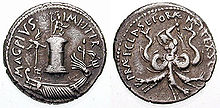
In the early 5th century BC Anaxilas, the tyrant of Rhegion , named the city Messene (Greek Μεσσήνη ) in honor of his hometown Messene in the Peloponnese . Messina was born in 396 BC. Sacked and sacked by the Carthaginians , then conquered by Dionysius I of Syracuse .
288 BC Messina was conquered by Campanian mercenaries, the so-called Mamertines , who killed all men and divided their wives, children and property among themselves. When Hieron II of Syracuse in 265 BC After taking measures against the ongoing threat, the Mamertines successively called Carthage and Rome for help, thus initiating the intervention of the two rising powers in Sicily, which subsequently led to their clash in the Punic Wars .
At the end of the First Punic War , Messina was a free city allied with Rome . Soon after, it became part of the province of Sicily.
In Roman times, the city received an important lighthouse. From 42 to 36 BC Messana, as the Romans called her, was the most important base of Sextus Pompeius during his sea war against Octavian .
middle Ages
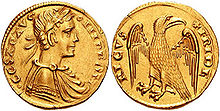
Up until the 9th century the city experienced an economic boom as an important trading center. In 843 the city was conquered by the Arabs and in 1061 by the Normans . In 1232 the city was the focus of an unsuccessful uprising against Emperor Friedrich II . After the rule of the Hohenstaufen and Anjous , Messina became the capital of the Regno di Sicilia under the rule of Aragon . It was not until the 16th century that Palermo became the preferred seat of kings and viceroys again.
Around 1450 there was a Giudecca (Jewish community) in the Paraporto quarter in Messina, which a lost synagogue stone tells of.
The coin of Messina minted gold coins with the title MNSC for Messana nobile siciliae caput in the Middle Ages . The coin survived until 1678, the end of Messina's rebellion against Spanish rule .
The city was also the seat of two important consulates. The Consolato del Mare , the consulate of the sea, regulated the legal disputes of merchant shipping in world trade . The Consolato della Seta was the consulate of the silk merchants .
Modern times
On February 5, 1783, an earthquake with a magnitude of 7.2 on the Richter scale struck the city. Most of the buildings, including the cathedral and the palaces of the Palazzata , were destroyed by the earthquake and the subsequent tidal wave. The reconstruction was based on a regular city map with wide streets and spacious squares. The palazzata was rebuilt from 1808 under the direction of Giacomo Minutoli in the classical style .
In his work "Walk to Syracuse", the writer Johann Gottfried Seume describes the Palazzata, a row of palaces on the port promenade of Messina, which was badly damaged by the earthquake:
“The harbor side is still in ruins and yet the only close walk for the city. The present sight shows what the whole thing must have been; and I really believe the Messinese were right when they said: there was nothing more splendid in the world than their façade on the harbor, which they therefore only preferred to call the palace, and it was still in ruins call so"
Seume also writes about another lost structure:
“The church of St. Gregorius ( San Gregorio ) on a fairly high elevation is rich in frescoes and marble work: but what is more important to me than this, it gives the most beautiful view of the city and the Gulf from its façade on the left and right; and with a good glass you have to be able to see what is happening on the opposite bank in Italy and in Rhegio on the streets. "

The Palazzata was rebuilt in 1808 by Giacomo Minutoli in the classicist style, but a hundred years later, the Messina earthquake in 1908 caused another heavy load on the Palazzata, Mannerist churches such as San Gregorio and San Annunziata and other buildings in the city (90% of the total building stock) Earthquake and a subsequent tsunami destroyed. More than 60,000 people were killed. The city was in the process of being rebuilt when allied air raids in 1943 destroyed over half of the buildings before the invasion .
In June 1955, the Messina Conference decided to found the European Economic Community . In the recent past, the city attracted attention with plans to build the bridge over the Strait of Messina on the E 45 .
Economy and Infrastructure
Messina is conveniently located at the narrowest point of the strait named after the city and is the commercial center of Sicily. The economy is industrial, the residents work in shipyards, in metal processing and in the chemical industry. Since the waters around Messina are very rich in fish, fishing and the food industry also play an economic role. The neighboring municipalities are Fiumedinisi , Itala , Monforte San Giorgio , Rometta , Saponara , Scaletta Zanclea and Villafranca Tirrena .
The shortest ferry connection to mainland Italy takes around 20 minutes to Villa San Giovanni . There are also ferries to the city of Reggio Calabria on the Calabrian shores and to Salerno, around 300 kilometers north, and to the Aeolian Islands . Controversial plans for a bridge over the Strait of Messina , which connects Sicily with mainland Italy, have been pushed forward again since Silvio Berlusconi's re-election in April 2008.
Messina is the starting point for the A18 to Catania and the A20 to Palermo .
The Messina Centrale train station is the starting point for the railway lines to Palermo and to Catania and Syracuse , which are mainly served by regional trains to Palermo and Catania. In addition, individual suburban trains run to Giampilieri on the route to Catania and Milazzo on the route to Palermo. From the Messina Marittima station , which is structurally connected to the Central Station , rail ferries run to Villa San Giovanni, with which the long-distance trains from Palermo or Catania to Rome and Milan are transferred to the mainland or in the opposite direction to Sicily. With the Messina tram , which went into operation in 2003, trams are running again after a 54-year interruption. In addition, numerous buses run to the places in the metropolitan city of Messina and to the larger cities.
The nearest airport is in Reggio Calabria in Calabria . The airports of Catania and Palermo offer numerous international connections.
Education and culture
Messina is home to one of the four universities in Sicily, the University of Messina . It was founded in 1548 and has eleven faculties. The university has a botanical garden.
One of the most important museums is the Museo Regionale di Messina . It shows paintings and statues from churches and palaces that were destroyed in the 1908 earthquake. There are numerous works by the painters Antonello da Messina and Girolamo Alibrandi , the sculptor Rinaldo Bonanno and other Messina artists .
The Museum of Culture and Folk Music of the Peloritans , opened in 1996, is dedicated to maintaining the oral cultural heritage such as B. folk music. The Military Museum of the fortifications of the Strait of Messina , opened on May 11, 2003, is located in the former Fort Cavalli, built between 1883 and 1902. The exhibits include cannons and bombs from World War II.
The Teatro Vittorio Emanuele II , a municipal theater, opened in 1852. It is one of the few buildings in Messina that was not destroyed by the earthquake. B. the Teatro Munizione .
The city's annual events include the Fiera di Messina , an international fair, as well as the popular festivals in Messina , which are held in June and August in honor of the patron saints and the city's founders.
Sports highlights are the home games of the successful soccer club FC Messina , which are played in the San Filippo stadium.
Buildings
Churches
The Cathedral of Messina , the cathedral of the Archdiocese of Messina-Lipari-Santa Lucia del Mela , was built in the 12th century and rebuilt in 1919/20 after the severe earthquake of 1908. In 1943 it was rebuilt after a fire. In 1254 the body of King Conrad IV, who had died shortly before, was burnt in the cathedral . The largest mechanical clock in the world is located in the free-standing bell tower.
The Madonna delle Grazie church is the work of Simone Gullì, the architect of the Palazzata. The church of Santissima Annunziata dei Catalani dates back to the 12th century and is one of the few buildings in the city that was not destroyed by earthquakes.
Santa Maria Alemanna or Santa Maria degli Alemanni is the only church in Sicily that was built in the 12th century in a purely Gothic style by master builders of the Teutonic Order . Only the side portal is preserved in its original form.
According to La judaica di Messina by Professor Giuseppe Martino, the synagogue of Messina is said to have been in the church of San Filippo Neri .
Palazzi
- Palazzo Zanca , the city hall, designed by Antonio Zanca
- Palazzo Monte di Pietà , built by Natale Masuccio (1616)
- Palazzo dell'Ina , designed by Viola and Samonà (1935)
- Banco di Sicilia , by Autore and V. Vinci (1936)
- Palazzo Littorio , designed by Viola and Samonà (1938)
- Palazzo dell'Inail designed by Viola and Samonà (1940)
- Palazzo of the province (or today's metropolitan city), known as Palazzo dei Lioni (Lions Palace), built in 1914 by Alessandro Giunta
- Palace of Justice , by Marcello Piacentini (1927)
- Chamber of Commerce and Industry , by Camillo Puglisi Allegra (1927)
- Palazzo Pensa , in the Giudecca with two gold-colored stars of David
Fountain
Fontana di Orione , the Orion Fountain, stands on Messina's cathedral square. The fountain was created by Giovanni Angelo Montorsoli in 1547 . The figures represent Orion , the mythical city founder Messina and the four other statues of the four rivers Nile , Tiber , Ebro and Camaro .
The Quattro Fontane (Italian for four fountains) were built at the four corners of the intersection of Via I. Settembre in 1847 and Via Cardines. They were made by Innocenzo Mangani in 1666 and by Ignazio Buceti in 1714 . Of the four wells, only two were returned to their original location after the 1908 earthquake. The other two fountains are now in the Museo Regionale di Messina .
Fontana del Nettuno , the Fountain of Neptune , was created in 1557 by the sculptor Giovanni Angelo Montorsoli . The fountain shows Neptune and at his feet the figures from Greek mythology Scylla and Charybdis .
Industrial buildings
- Planned bridge over the Strait of Messina
- High-voltage pylons of the former overhead line across the Strait of Messina
Personalities
Famous personalities of the city are included in the list of personalities of the city of Messina .
literature
- Luigi Monzo: croci e fasci - Italian church construction in the time of fascism, 1919–1945. 2 vol. Karlsruhe 2017 (dissertation, Karlsruhe Institute of Technology, 2017), pp. 699–769. (To rebuild Messina after the earthquake of 1909)
- Enrico Pispisa: Messina medievale, Galatina: Congedo 1996 (Le città del Mezzogiorno medievale 1). ISBN 88-8086-147-6
- Anthony Blunt: "Sicilian Baroque"
- Johann Wolfgang von Goethe: "Italian Journey" (Viaggio in Italia) 1817
- Peter Murray: "The Architecture of the Renaissance", Italy Verlag Gerd Hatje, Stuttgart
- Wilhelm Meyer u. Maxim Gorki: "In the Destroyed Messina", J. Ladyschnikow Verlag , Berlin 1909
Web links
Individual evidence
- ↑ Statistiche demografiche ISTAT. Monthly population statistics of the Istituto Nazionale di Statistica , as of December 31 of 2019.
- ↑ Thucydides VI 4,5-6: “Zankle was originally founded when pirates arrived from Kyme, a Chalcidian city in Opikia. Later, however, a large number of people came from Chalcis and the rest of Euboea and divided the country among themselves. Its founders were Perieres and Krataimenes , the one from Kyme, the other from Chalkis. The Sikeler first called it Zankle because the place has a sickle-shaped appearance and the Sikeler call the sickle Zanklon. They are later chased away by the Sami and other Ionians who fled the Medes and ended up in Sicily. The Samians, however, were soon driven out by Anaxilas, the tyrant of Rhegion; for his part, he settled the city with a mixed population and changed its name to Messene after his old hometown. "
- ↑ Süddeutsche Zeitung
- ↑ New tram from Messina (in Italian)
- ↑ Josef Riedmann: Konrad IV as King of the Regnum Siciliae. In: Karl-Heinz Rueß (Ed.): Konrad IV. (1228–1254). Germany's last Hohenstaufen king. Göppingen 2012, here p. 92.

